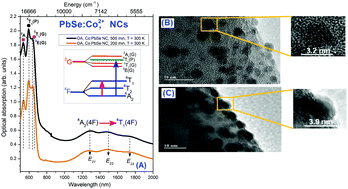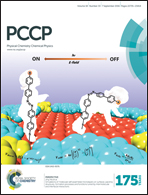Tunable dual emission in visible and near-infrared spectra using Co2+-doped PbSe nanocrystals embedded in a chalcogenide glass matrix
Abstract
Semimagnetic Pb1−xCoxSe nanocrystals were synthesized by a fusion protocol in a glass matrix and characterized by optical absorption (OA), transmission electron microscopy (TEM), and photoluminescence (PL) techniques. OA spectra and TEM images strongly indicated the formation of Pb1−xCoxSe magnetic phases in the glass system and the quantum dot size was manipulated by tuning the annealing time. The OA spectra together with crystal field theory indicate that Co2+ is located in the tetrahedral site (Td) and the PL of the Pb1−xCoxSe nanocrystals presents characteristic recombination in the visible (∼700 nm) and near-IR (1300–1600 nm) electromagnetic spectral range. With temperature decreasing, the PL spectra, in the visible spectral range, indicate an excited-state crossover yielding PL changes from 4T1(P) → 4A2(F) broadband emission to 2E(G) → 4A2(F) narrow-line emission. This phenomenon was explained on the basis of a configurational energy model. The OA and PL spectra of PbSe:Co2+ indicate that the localized energy transition of Co2+ (4A2(F) ↔ 4T1(4F)) can be tuned from the band-gap energy to the conduction-band energy of PbSe NCs by changing the NC size by increasing the thermal annealing time. In the near-IR spectral range, the temperature-dependent PL spectra show that the process of thermal activation of localized electrons in Co2+ states can be transferred to the conduction band of the NCs. This process depends on the energy distance between extended and localized states, which can be controlled by the sample annealing time.


 Please wait while we load your content...
Please wait while we load your content...